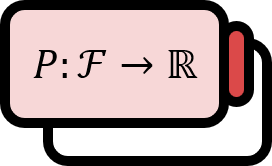확률론에서의 세퍼레이팅 클래스
정리
가측 공간 $(S, \mathcal{B}(S))$ 에서 정의된 두 확률 $P$, $Q$ 에 대해 다음을 만족하는 $\mathcal{C}$ 를 세퍼레이팅 클래스separating class라고 한다. $$ P(A) = Q(A), \forall A \in \mathcal{C} \implies P(A) = Q(A), \forall A \in \mathcal{B}(S) $$
설명
세퍼레이팅 클래스가 존재한다는 것은 두 측도가 서로 같은지 확인하기 위해서 가측 공간 전체가 아니라 일부만 확인하면 된다는 의미가 된다. 상식적으로 이렇게 좋은 클래스가 그냥 존재해 줄 리는 없을 것 같지만, 다음의 정리에 따라 비교적 쉬운 조건으로 찾아낼 수 있다.
정리
파이 시스템 $\mathcal{C}$ 에 대해 $\sigma (\mathcal{C}) = \mathcal{B}(S)$ 고 모든 $A \in \mathcal{C}$ 에 대해 $P(A) = Q(A)$ 면 $\mathcal{C}$ 는 세퍼레이팅 클래스다.
용도
파이 시스템이라는 조건은 직접 세퍼레이팅 클래스의 정의를 직접 만족시키는 것과 비교해서 훨씬 달달하다. 이러한 정리가 있다면 세퍼레이팅 클래스의 존재성을 보이기 쉬울 것이고, 결국 두 확률 (측도)가 같다는 것을 보여주기가 쉬워질 것이다.
증명
딘킨의 파이-람다 정리를 사용하기 위해 다음의 정의를 소개한다.
- 다음을 만족하는 $\mathcal{P}$ 을 $\pi$-시스템이라고 한다. $$ A, B \in \mathcal{P} \implies A \cap B \in \mathcal{P} $$
- 다음의 조건들을 만족하는 $\mathcal{L}$ 을 $\lambda$-시스템이라고 한다.
- (i): $\emptyset \in \mathcal{L}$
- (ii) $A \in \mathcal{L} \implies A^{c} \in \mathcal{L}$
- (iii) 모든 $i \ne j$ 에 대해 $\displaystyle A_{i} \cap A_{j} = \emptyset$ 일 때 $$\displaystyle \left\{ A_{n} \right\}_{n \in \mathbb{N}} \subset \mathcal{L} \implies \bigcup_{n \in \mathbb{N}} A_{n} \in \mathcal{L}$$
$\mathcal{L} := \left\{ A \in \mathcal{B}(S) : P(A) = Q(A) \right\}$ 이라고 정의하면
- (i): $P( \emptyset ) = Q (\emptyset ) = 0$ 이므로 $\emptyset \in \mathcal{L}$ 이다.
- (ii): $P(A^{c}) = 1 - P(A) = 1 - Q(A) = Q(A^{c})$ 이므로 $A \in \mathcal{L} \implies A^{c} \in \mathcal{L}$ 이다.
- (iii): 확률 $P$, $Q$ 는 측도이므로 $\displaystyle \left\{ A_{n} \right\}_{n \in \mathbb{N}} \subset \mathcal{L} \implies \bigcup_{n \in \mathbb{N}} A_{n} \in \mathcal{L}$ 을 만족한다. 따라서 $\mathcal{L}$ 은 람다 시스템이다.
가정에서 $\mathcal{C}$ 모든 $A \in \mathcal{C}$ 에 대해 $P(A) = Q(A)$ 이었으므로 $\mathcal{C} \subset \mathcal{L}$ 이다.
딘킨의 파이-람다 정리: 파이 시스템 $\mathcal{P}$ 가 람다 시스템 $\mathcal{L}$ 의 부분집합이면 $\mathcal{P} \subset \sigma ( \mathcal{P} ) \subset \mathcal{L}$ 을 만족하는 시그마 필드 $\sigma ( \mathcal{P} )$ 가 존재한다.
가정에서 $\mathcal{C}$ 는 파이 시스템이었으므로 딘킨의 파이-람다 정리에 따라 $\mathcal{C} \subset \sigma ( \mathcal{C}) \subset \mathcal{L}$ 을 만족하는 $\sigma ( \mathcal{C}) = \mathcal{B}(S)$ 가 존재한다. 물론 $\mathcal{L}$ 의 정의에서 $\mathcal{L} \subset \mathcal{B}(S)$ 이므로 $\mathcal{L} = \mathcal{B}(S)$ 이고, $P(A) = Q(A)$ 를 만족하는 $A \in \mathcal{C}$ 가 $\mathcal{B}(S)$ 에도 속함을 의미한다. 다시 말해 모든 $A \in \mathcal{B}(S)$ 에 대해 $P(A) = Q(A)$ 이고, 이를 명제꼴로 고쳐쓰면 다음과 같다. $$ P(A) = Q(A), \forall A \in \mathcal{C} \implies P(A) = Q(A), \forall A \in \mathcal{B}(S) $$
■

 저희들의 저서 「줄리아 프로그래밍」이 2024 세종도서 학술부문에 선정되었습니다!
저희들의 저서 「줄리아 프로그래밍」이 2024 세종도서 학술부문에 선정되었습니다!

